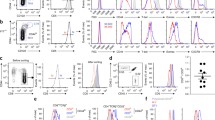Abstract
T-Iymphocyte co-recognition of antigen and major histocompati-bility complex (MHC)-encoded molecules (such as murine Ia molecules) is thought to be mediated by a single cell-surface receptor, although the molecular mechanism by which this occurs is controversial (reviewed in ref. 1). One possibility is that the antigen molecule and the Ia molecule interact physically, either before or after encountering the T-cell antigen-specific receptor1,2. Alternatively, both molecules could bind to the receptor independently of one another, accounting for the dual specificity of the receptor without postulating a physical interaction between a limited number of Ia molecules present in any given animal and the myriad antigens to which T cells can respond. Here, we used a recently described approach for analysing the relative avidity of the T-ceil receptor for different ligands3 to address these two possibilities. We describe a T-cell clone whose response to a single antigen, presented in the context of two different Ia molecules, strongly suggests that the antigen and the Ia molecule interact physically.
Similar content being viewed by others
References
Schwartz, R. H. Adv. Immun. 38, 31–201 (1986).
Babbitt, B. P., Allen, P. M., Matsueda, G., Haber, E. & Unanue, E. R. Nature 317, 359–361 (1985).
Ashwell, J. D., Fox, B. S. & Schwartz, R. H. J. Immun. 136, 757–768 (1986).
Cuatrecasas, P. & Hollenberg, M. D. Adv. Protein Chem. 30, 251–451 (1976).
Moyle, W. E., Lee, E. Y., Bahl, O. P., Garfink, J. E. & Rodbard, D. Am. J. Physiol. 232, E274–E285 (1977).
Moyle, W. R., Lee, E. Y., Bahl, O. P. & Rodbard, D. in Receptors and Hormone Action (Academic, New York, 1978).
Mengle-Gaw, L. & McDevitt, H. O. A. Rev. Immun. 3, 367–396 (1985).
Heber-Katz, E., Hansburg, D. & Schwartz, R. H. J. molec. cell. Immun. 1, 3–14 (1983).
Schwartz, R. H., Heber-Katz, E. & Hansburg, D. in Intercellular Communication in Leukocyte Function (Wiley, Chichester, 1983).
Cleveland, W. L. & Erlanger, B. F. Molec. Immun. 21, 1037–1046 (1984).
Zinkernagel, R. M. & Doherty, P. Nature 251, 547–548 (1974).
Sherman, L. Nature 292, 511–513 (1982).
Carel, S., Bron, C. & Corradin, G. Proc. natn. Acad. Sci. U.S.A. 80, 4832–4836 (1983).
Rao, A., Weng-Ping, W., Faes, S. J. & Cantor, H. Cell 36, 879–888 (1984).
Siliciano, R. F., Keegan, A. D., Dintzis, R. Z., Dintzis, H. M. & Shin, H. S. J. Immun. 135, 906–914 (1985).
Matis, L. A., Glimcher, L. H., Paul, W. E. & Schwartz, R. H. Proc. natn. Acad. Sci. U.S.A. 80, 6019–6023 (1984).
Schwartz, R. H., Fox, B. S., Fraga, E., Chen, C. & Singh, B. J. Immun. 135, 2498–2608 (1985).
Schwartz, R. H. A. Rev. Immun. 3, 237–261 (1985).
Author information
Authors and Affiliations
Rights and permissions
About this article
Cite this article
Ashwell, J., Schwartz, R. T-cell recognition of antigen and the Ia molecule as a ternary complex. Nature 320, 176–179 (1986). https://doi.org/10.1038/320176a0
Received:
Accepted:
Issue Date:
DOI: https://doi.org/10.1038/320176a0
- Springer Nature Limited
This article is cited by
-
Activation and enhanced contact of human T-lymphocytes with autologous red blood cells are required for their stable adherence at 37°
Virchows Archiv B Cell Pathology Including Molecular Pathology (1993)
-
Modulation of T cell responses with MHC-derived peptides
Immunologic Research (1992)
-
Immunogenicity and immunochemistry ofStreptococcus pneumoniae capsular polysaccharides
Antonie van Leeuwenhoek (1990)





